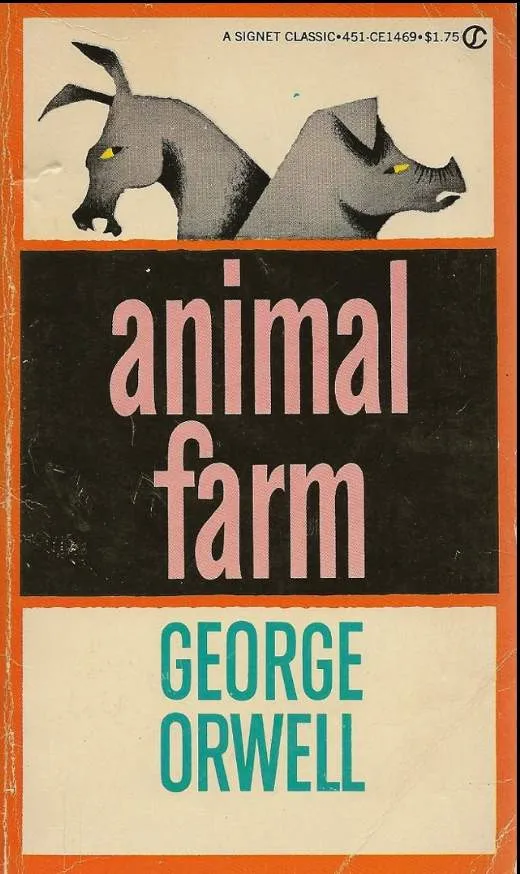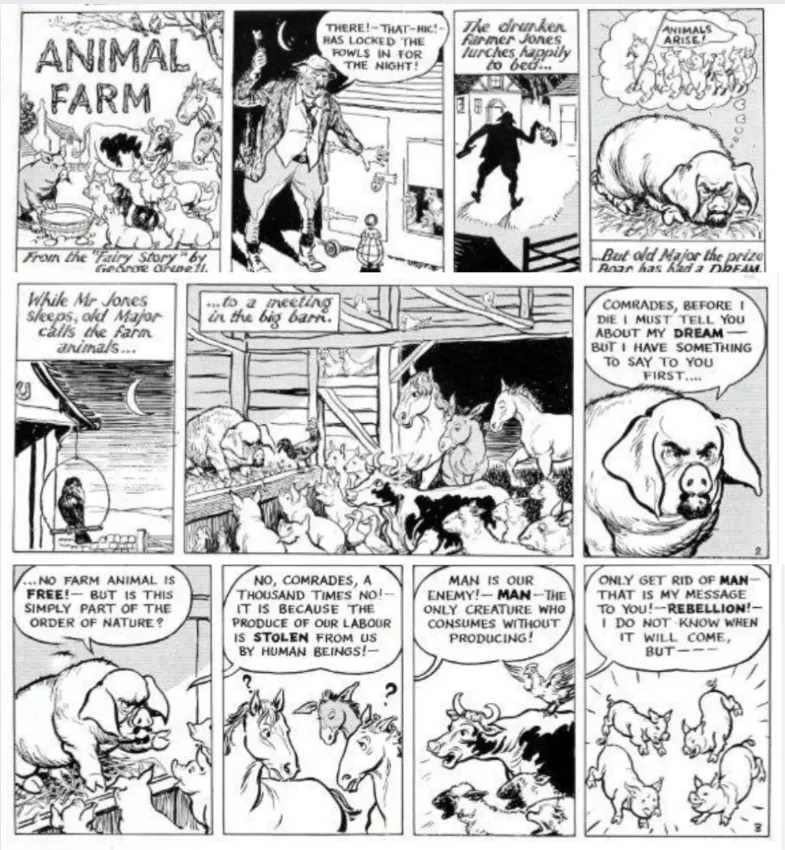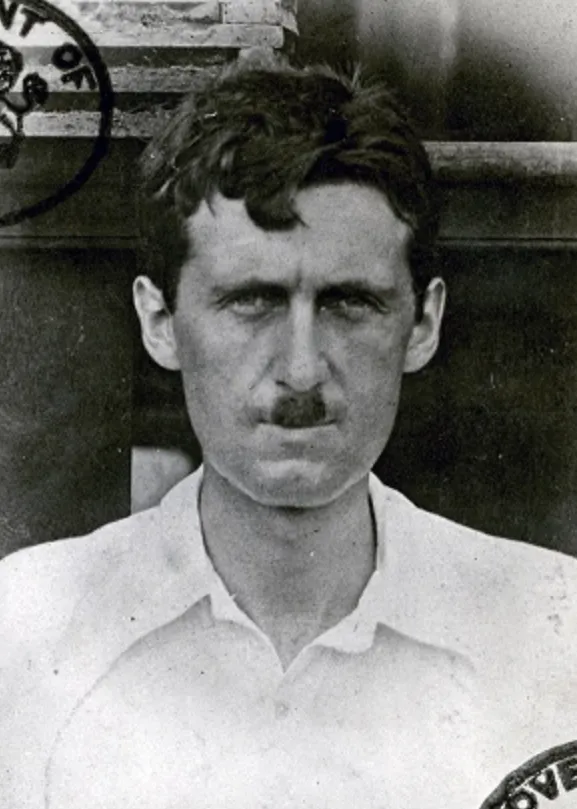Orwell's Britain: Inside the IRD, the Cold War Ministry of Truth (& Deception)
As US spies charmed George Orwell’s widow into selling the film rights to Animal Farm, British spooks were also circling in 1950. Their goal was to secure the rights to produce an Animal Farm comic strip.
Britain’s cunning plan was to distribute propaganda cartoons to newspapers through its embassies in Cairo, Caracus, and beyond. The distribution was to be overseen by a unit known as the Information Research Department (IRD), an arm of the Foreign Office that countered Soviet propaganda.

Once the comic strip rights were secured, the IRD’s animators set about narrating the entire story through three- or four-panel strips that could be published over 13 weeks in foreign papers, strategically disseminating Orwell's message to an international audience. IRD artist Donald Freeman provided the 'roughs' while cartoonist Norman Pett sketched the final drawings.
It was a propaganda coup for Britain’s spies. Orwell’s enduring novel - a satirical narrative of animals seizing control of their farm only to plunge into another oppressive regime - gained even further prominence when the CIA secretly funded the 1954 animated film by the British team Halas and Batchelor, reinforcing the message.

"The brand new social experience where you activate your gaming skills as you train like a spy."
- TimeOut
Take on thrilling, high-energy espionage challenges across different game zones.

Animal Farm: Spies and Propaganda
The IRD saw the value of Orwell’s story as a powerful tool in the Cold War. “This work has been translated into many languages, and has proved to be not only a bestseller but also a most effective propaganda weapon because of its skillful combination of simplicity, subtlety, and humor,” Britain’s National Archive noted in 2020, some 75 years after the cartoon strips first appeared.
The Archive also revealed the Cold War exchange between the IRD’s Lt. Col. Leslie ‘Sherry’ Sheridan and artists Freeman and Pett, providing a glimpse into the intricate work required to condense Orwell's narrative for a cartoon-consuming audience. Sherry had been a wartime propagandist with Britain’s Special Operations Executive (SOE) and its forerunner, Section D (for destruction).
Don Freeman shared his professional concerns about translating Orwell’s work with Sherry, including his worry that the story was so tightly woven he might cut one element and affect the narrative: “My difficulty all along has been the tightly-packed ‘meatiness’ of the story.” Freeman said, and acknowledged taking a few liberties, guided by the spirit of the book.

Animal Farm: Orwell’s allegory
The depiction of Boxer, the great cart horse and model worker symbolizing the Soviet Stakhanovite movement, proved to be another challenge. Sherry wasn’t a fan of the early depictions of Boxer, using language that would likely be regarded as politically incorrect today.
Other early scenes were viewed more favorably including 'Old Major' - the pig based on Karl Marx and Vladimir Lenin - and 'Napoleon,' a dominant figure resembling former Soviet leader Joseph Stalin. The artistic interpretation aligns seamlessly with Orwell's allegorical intent.
The IRD wasn’t the only outlet producing Animal Farm cartoons. Harold Whitaker, one of the film’s lead animators, produced a comic-strip version for British newspapers to help promote the animated movie’s release in 1954. It is preserved in book form today. The IRD strips were certainly the sneakiest drawings, however.

The Information Research Department
The inner workings of the IRD are still being investigated as historical files are declassified. Britons only discovered in 2019 that the IRD used forged documents to produce ‘fake news’ during the Cold War. For three decades, the IRD fed disinformation to journalists and academics, and even operated its own news agencies.
The IRD also published black propaganda, designed to sow chaos and destabilize Britain’s enemies. It was most active in the ‘60s when it employed 400 to 600 staff, according to Paul Lashmar, author of Britain's Secret Propaganda War and one of the journalists who exposed the IRD’s existence.

By the 1970s, the IRD was performing military intelligence tasks in Northern Ireland during The Troubles as well as promoting works by anti-communist authors including Bertrand Russell, Arthur Koestler, and George Orwell.
Ironically, Orwell, the author who warned of the dangers of totalitarianism and the surveillance state, became an IRD informer a year before he died in 1950.
Orwell, through a former love, provided the IRD with a list naming suspected communists who might betray Britain if they were hired to work as writers in the government’s propaganda unit. Orwell’s list included famous names such as the comic actor Charlie Chaplin (with a question mark next to his name), actor Michael Redgrave, and playwright J.B. Priestley.
The IRD - founded in 1944 - reportedly closed its operations in 1977 after its existence was discovered by journalists. At least, that’s the official story.
_____
Own a Piece of Cold War Movie History! Dive into our collection of rare treasures from our film archives - original, hand-painted movie cels, perfectly paired with their original drawings. These extraordinary artifacts were pivotal in creating the 1954 animated classic Animal Farm, a cinematic gem financed by the CIA as a propaganda tool to fight communism during the intense Cold War period.
SPYSCAPE+

Join now to get True Spies episodes early and ad-free every week, plus subscriber-only Debriefs and Q&As to bring you closer to your favorite spies and stories from the show. You’ll also get our exclusive series The Razumov Files and The Great James Bond Car Robbery!


Gadgets & Gifts
Explore a world of secrets together. Navigate through interactive exhibits and missions to discover your spy roles.
Your Spy Skills
We all have valuable spy skills - your mission is to discover yours. See if you have what it takes to be a secret agent, with our authentic spy skills evaluation* developed by a former Head of Training at British Intelligence. It's FREE so share & compare with friends now!
* Find more information about the scientific methods behind the evaluation here.


Stay Connected
Follow us for the latest
TIKTOK
INSTAGRAM
X
FACEBOOK
YOUTUBE